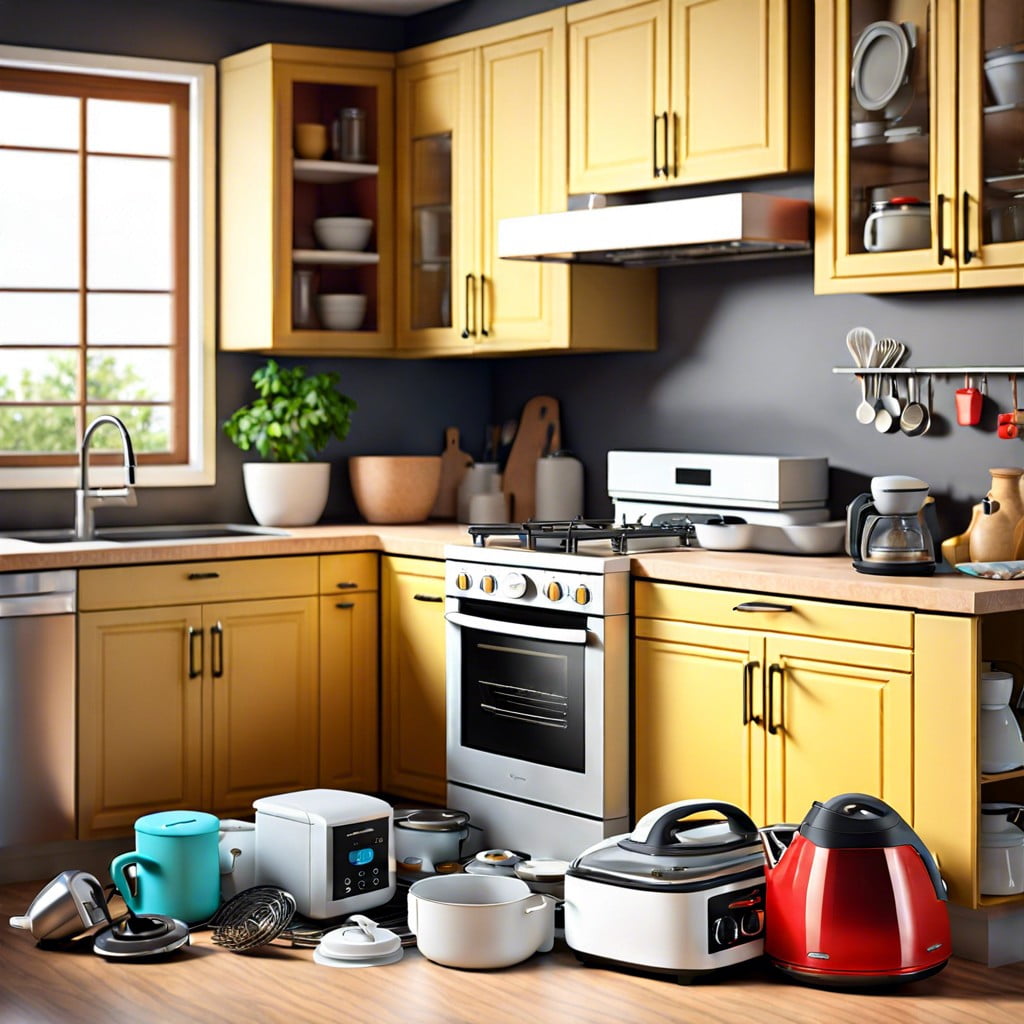Last updated on
This article provides practical steps to declutter your kitchen efficiently, turning chaos into order with straightforward solutions.
Key takeaways:
- Assess kitchen clutter with an inventory and three-box method.
- Plan and prepare with a schedule and gather necessary supplies.
- Declutter by sorting into categories and being ruthless with what stays.
- Optimize organization with dividers, risers, labels, and hanging organizers.
- Maintain a clutter-free kitchen with minimalism, daily tidying, one-in-one-out rule, clear storage containers, and periodic reviews.
Table of Contents
Assess Your Kitchen Clutter

Start by observing the chaos with a bird’s-eye view—or as close to it as your ceiling allows. Note piles of paperwork on countertops, the overabundance of plastic containers (seriously, how did they multiply?), and gadgets you don’t remember buying.
Make a list. Divide items into categories: utensils, appliances, dishes, pantry items, and so on. This “inventory” helps to visually digest which areas are most congested.
Use the three-box method. Grab three boxes or bins, label them: “Keep,” “Donate/Sell,” “Trash.” As you sift through your items, this quick-sort can be a real game-changer—helping you rapidly decide the fate of each item without allowing time for sentimental sappiness to cloud your judgment.
Remember, this step isn’t about rearranging. It’s about facing the chaos head-on and preparing to tame the kitchen wilderness. Keep an eye out for duplicates and unnecessary items that have been lurking in drawers and cabinets like culinary ninjas.
Plan & Prepare
Before diving into the monumental task of decluttering your kitchen, a solid plan is your best ally. Start by scheduling a block of time dedicated solely to this project; a clutter-free weekend, perhaps? Gather necessary supplies like garbage bags, boxes for donations, and cleaning products so you won’t have to pause mid-declutter for a supply run.
Next, consider your workflow in the kitchen. Which items do you use daily? Weekly? Rarely? This will guide you in deciding what stays within easy reach and what can be stored further away or even let go.
Don’t forget to make a list or take pictures of items you notice are broken, missing parts, or need replacing. It’s essential to know what needs to be fixed or bought new without getting sidetracked during your decluttering spree.
Declutter Like a Boss
Start by sorting everything into categories. Group your utensils, gadgets, dishes, and food items. This way, you’ll see what you have duplicates of or what you rarely use.
Next, tackle the toughest part: deciding what stays and what goes. If you haven’t used something in a year, it’s likely you don’t need it. Be merciless with gadgets that have only one use. A melon baller? Really? When was the last time you made a melon ball?
Create a ‘maybe box’ for items you’re unsure about. Store it away and if you don’t reach for anything in it within a month, it might be time to say goodbye.
Remember, every item needs a home. If you can’t find a proper place for something, it’s a sign it probably shouldn’t be in your kitchen. This will help keep your counters free of the perpetual ‘stuff’ pile.
Lastly, label everything. Not just the obviously label-worthy like bins and jars. Ever found yourself debating the mysterious frozen soup identity in your freezer? Label it before you store it. It’s a simple step that prevents a lot of future clutter.
Optimize Your Organization
To start, consider installing drawer dividers in overstocked drawers to instantly civilize the chaos. These nifty organizers allow you to designate homes for utensils, making them easier to locate when your culinary flair kicks in.
Next up, introduce shelf risers where stacks of dishes tower precariously. They double your shelf space and make it simpler to grab that salad plate without triggering a porcelain avalanche.
Labeling is your friend. Mark clear storage containers with their contents and expiration dates. It not only saves you from sniffing mystery ingredients but also keeps your pantry looking neat and your food waste under control.
Don’t overlook the power of hanging organizers. They’re perfect for moving clunky items off your counter. Whether it’s hanging pots, pans, or utensils, having them out and visible streamlines both cooking and cleaning.
Lastly, adjust your storage areas dynamically based on usage. Frequently used items like oils and spices should be within easy reach, perhaps on a lazy Susan, while lesser-used items can take a back seat in higher or deeper cabinets. This way, efficiency isn’t just an ideal; it’s a practical everyday reality.
Tips for Maintaining a Clutter-free Kitchen
The battle against kitchen clutter doesn’t end after a clean sweep; it’s an ongoing war. Here are some strategies to keep your newly liberated counters free from the clutches of clutter.
- Embrace minimalism on countertops: Reserve this prime real estate for essentials only. The coffee maker can stay, but the rarely used spiralizer? Time to store it away!
- Daily mini-declutters: Take five minutes before bedtime to reset. Clear out any stray items and wipe down surfaces. This nightly ritual keeps chaos at bay.
- Adopt the one-in-one-out rule: New kitchen gadget arrives? Another must leave. This maintains equilibrium and ensures that your kitchen tools don’t start secretly multiplying in the drawers.
- Use clear storage containers: Not only do they stack neatly, but they also let you see what’s inside at a glance, reducing the urge to overbuy or duplicate items.
- Schedule periodic reviews: Every season, take an hour to assess your kitchen setup. Tweak and reorganize as necessary to keep everything functional and fresh.
By incorporating these habits, your kitchen will remain a model of organization and efficiency, making cooking and cleaning less of a chore and more of a joy.




